Oporto Sightseeing
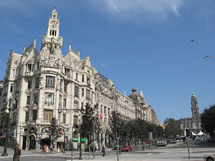
Porto City Centre
The first place to begin with is the Ribeira, the part of the city near the river, which is also a good place to start visiting the World Heritage area; to the other side of the river you will see the Ribeira de Gaia, a similar area from the city of Vila Nova de Gaia (the two are only separated by the river) and where you could find the Port Wine Cellars. Next go up to the São Francisco church and the Stock Exchange palace nearby, where you can visit the most impressive Arab room in the country. The world known Modern Art museum at Serralves and the Casa da Música (House of Music) concert hall live in the area known as Boavista. From there you can reach the amazing ocean front drive, known as "Foz". Go back to the center of the city and visit Mercado do Bolhão, a traditional market of fruits, vegetables, fish and meat. Next the Aliados and the City Hall and finally the 6 bridges connecting Porto to Gaia over the Douro river, many of them providing an excellent view to the river. Porto is a mysterious city that reveals its charm to the visitor through time. Take your time, wander through the mazes and alleys of the city. Take in the old, bohemian spirit of the city. Hike through the Ribeira and Foz do Douro regions (the latter, at sunset). Porto may not be in every tourist's Iberian Peninsula itinerary, but it's well worth a visit if you want to see a city that has changed economically, but that has kept its old traditions, something that is being forgotten in Europe today.
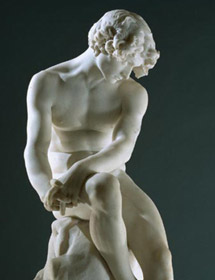
Soares dos Reis
National Museum Soares dos Reis (Portuguese: Museu Nacional Soares dos Reis), located in the ancient Carrancas Palace, in Porto, Portugal, is one of the most renowned Portuguese museums. The museum Soares dos Reis, founded in 1833, is Portugal's first national museum. It displays one of the finest collections of Portuguese art, in particular a gallery of works by Portuguese sculptor António Soares dos Reis, after whom the museum is named. The museum has a vast collection mainly focused on Portuguese art of the 19th and 20th centuries, including painting, sculpture, furniture, metalwork and ceramics.
Fundação de Serralves
A contemporary Museum designed by the famous architect Álvaro Siza, with a huge garden/park and an Art Deco Villa. When visiting this foundation you can visit the exhibitions, relax at the park, have lunch at the restaurant, bar or tea house and explore the shops or the library.
Livraria Lello
Near Praça dos Leões. It's an old Bookshop, with an amazing interior, where you can also have a coffee. Voted as one of the most beautiful bookshops in Europe.
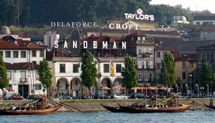
Vila Nova de Gaia
Vila Nova de Gaia is a city in Oporto (Porto) district of Northern Portugal. It is home of cellars of port wine, several shopping centers and some of the best beaches. Perhaps the most famous tourist attraction in Gaia are the Port Wine Cellars, warehouses where the famous Port wine is stored. The Cellars are placed in Ribeira de Gaia, an area of the city located in the bank of River Douro opposite Porto. Ribeira de Gaia has also some typical and international restaurants, particularly in Cais de Gaia. Even if you are not in visiting the cellars, you should visit Ribeira the Gaia in order to get some amazing views of Porto.
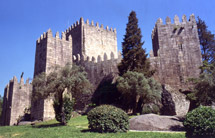
Guimarães
Guimarães is a city in Minho, Portugal and is one of the most historical cities in Portugal, said to be where "Portugal was born". It is the first city of Portugal, and have a beautiful Castle, and a Palace to visit, from the beginnings of the country. The Castle has been classified as one of the New Portuguese Seven Wonders. The first King (D. Afonso Henriques aka D. Afonso, I of Portugal) is still being idolized by the city. Placed about 50 km from Porto, Guimarães is placed near to a mountain, Penha, with wonderful views to all the city.
Guimarães Castle, located in the very centre of the city, this castle have been constructed in the X Century, ordered by Mumadona Dias, with the purpose to defend the city from the Muslims. The first name of the Castle was "São Mamede Castle", name given by Mumadona. The first king, Afonso Henriques, lived in this Castle, and started conquering Portugal from the Muslims from this place. Very well kept, the castle is of the greatest historical symbols in Portugal. It has been classified by UNESCO, as World Heritage.
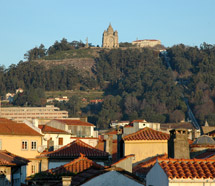
Viana do Castelo
Viana do Castelo is one of the most beautiful portuguese cities, in the Minho-Lima subregion of Northern Portugal. The Pilgrimage of Nossa Senhora da Agonia and the amazing views of the Lima River maked this city unforgettable. Classified as the Mecca of Architecture, the city is famous for the monuments in and around the city, and the surrounding natural beauty.
Basilica of Santa Luzia, on Mt. St. Luzia - Constructed in 1903, it was inspired by the Sacré Coeur de Montmartre in Paris. From the basilica's location on top of Mount St. Luzia, there are spectacular views of the city and the beach. The best view of the city can be seen from the pinnacle of the church, accessible from the church through an elevator or through the stairs. You can reach the basilica either by car via the Santa Luzia highway, or by taking the Santa Luzia Elevator.
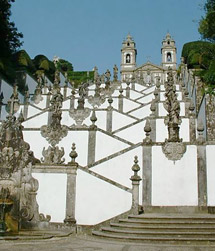
Braga
Braga is a city in the Cávado Valley of Northern Portugal. It is the fifth largest city in Portugal,after Lisbon,Porto,Amadora and Vila Nova de Gaia.It is an ancient and modern city,one of the most important Archdiocese.
Bom Jesus do Monte is a Portuguese sanctuary in the surroundings of the city of Braga, in northern Portugal. Its name means Good Jesus of the Mount. The Sanctuary is a notable example of pilgrimage site with a monumental, Baroque stairway that climbs 116 metres (381 feet). It is an important tourist attraction of Braga.
